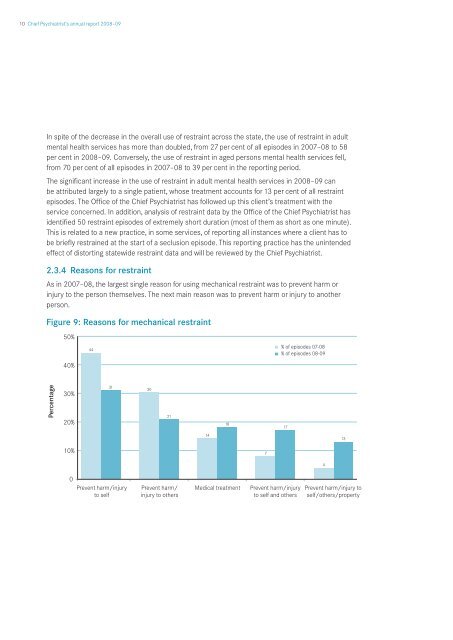Chief Psychiatrist's annual report 2008-09 - Department of Health
Chief Psychiatrist's annual report 2008-09 - Department of Health
Chief Psychiatrist's annual report 2008-09 - Department of Health
Create successful ePaper yourself
Turn your PDF publications into a flip-book with our unique Google optimized e-Paper software.
10 <strong>Chief</strong> Psychiatrist’s <strong>annual</strong> <strong>report</strong> <strong>2008</strong>–<strong>09</strong><br />
In spite <strong>of</strong> the decrease in the overall use <strong>of</strong> restraint across the state, the use <strong>of</strong> restraint in adult<br />
mental health services has more than doubled, from 27 per cent <strong>of</strong> all episodes in 2007–08 to 58<br />
per cent in <strong>2008</strong>–<strong>09</strong>. Conversely, the use <strong>of</strong> restraint in aged persons mental health services fell,<br />
from 70 per cent <strong>of</strong> all episodes in 2007–08 to 39 per cent in the <strong>report</strong>ing period.<br />
The significant increase in the use <strong>of</strong> restraint in adult mental health services in <strong>2008</strong>–<strong>09</strong> can<br />
be attributed largely to a single patient, whose treatment accounts for 13 per cent <strong>of</strong> all restraint<br />
episodes. The Office <strong>of</strong> the <strong>Chief</strong> Psychiatrist has followed up this client’s treatment with the<br />
service concerned. In addition, analysis <strong>of</strong> restraint data by the Office <strong>of</strong> the <strong>Chief</strong> Psychiatrist has<br />
identified 50 restraint episodes <strong>of</strong> extremely short duration (most <strong>of</strong> them as short as one minute).<br />
This is related to a new practice, in some services, <strong>of</strong> <strong>report</strong>ing all instances where a client has to<br />
be briefly restrained at the start <strong>of</strong> a seclusion episode. This <strong>report</strong>ing practice has the unintended<br />
effect <strong>of</strong> distorting statewide restraint data and will be reviewed by the <strong>Chief</strong> Psychiatrist.<br />
2.3.4 Reasons for restraint<br />
As in 2007–08, the largest single reason for using mechanical restraint was to prevent harm or<br />
injury to the person themselves. The next main reason was to prevent harm or injury to another<br />
person.<br />
Figure 9: Reasons for mechanical restraint

















